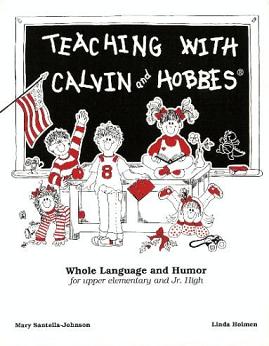Teaching with Calvin and Hobbes facts for kids
 |
|
| Author | Linda Holmen, Mary Santella-Johnson, Bill Watterson |
|---|---|
| Illustrator | Jan Roebken, Bill Watterson |
| Cover artist | Jan Roebken |
| Country | United States |
| Language | English |
| Subject | Speech and language pathology |
| Genre | Children's textbook |
| Publisher | Playground Publishing |
|
Publication date
|
1993 |
| Media type | Print (Paperback) |
| Pages | 200 |
| ISBN | 1-878849-15-8 |
| OCLC | 29340469 |
Teaching with Calvin and Hobbes is a special American textbook published in 1993. It's quite rare because it's one of the very few official items ever made for the famous comic strip Calvin and Hobbes. This makes it a highly sought-after collectible for fans.
What's Inside the Book?
This book was written by a speech-language pathologist (someone who helps people with speaking and understanding language) and an educator who works with children who have learning disabilities. It's a language textbook designed for elementary and middle school students. The cover and some pictures inside were drawn by Jan Roebken.
The book features 57 different Calvin and Hobbes comic strips. These strips are grouped into five lesson units. Each unit starts with a series of comic strips that tell a story. The five units are:
- "The Binoculars": Calvin breaks his dad's binoculars and asks Hobbes for advice.
- "The Find": Calvin discovers and puts together a kind of dinosaur skeleton. Hobbes then draws a picture of this creature.
- "The Christmas Story": Calvin tries to be good so Santa will visit. He and Hobbes talk about rules and what it means to believe in things.
- "The Bug Collection": Calvin forgets his homework and tries to finish it on the way to school. His friend Susie ends up in trouble.
- "The Report": Calvin and Susie are given a homework project to do together.
After the comic strips in each unit, there are questions to help students understand what they read and talk about it together. Here are some examples of the questions:
- Do you think Calvin's mother should have told Calvin the truth about his dinosaur? Why or why not? [...]
- Imagining and creating are important and fun, but, when it goes too far, it's time to get back to reality. Do you think Calvin was disappointed when his mother brought him back to reality or do you think he always had an inkling that he was having fun with his imagination?
- Can you think of a time when you were imagining or creating and your mom or dad brought you back to reality?
- Were you disappointed to get back to reality?
Teachers Sandra F. Rief and Julie A. Heimburge have highly recommended Teaching with Calvin and Hobbes as a great educational tool in their own books.
Why is This Book So Rare?

The creator of Calvin and Hobbes, Bill Watterson, famously refused to let his comic strip be used for most merchandise like toys or T-shirts. This book is very special because it's one of the few exceptions. The authors were able to get permission from Watterson himself. They explained to him how successful they were using his comic strips to help children with learning disabilities.
Because it was printed in a small number of copies in Fargo, North Dakota, Teaching with Calvin and Hobbes is very hard to find. It is highly wanted by collectors.
Nevin Martell, who wrote a book about Calvin and Hobbes, said that it took him a long time to find a copy of Teaching with Calvin and Hobbes. He also mentioned that copies of the book sell for very high prices. He called it "perhaps the most difficult piece of official Calvin and Hobbes memorabilia to find."
In 2009, one copy of the book was recorded as selling for US$10,000. By 2012, some people valued the book at up to US$34,000. In 2013, a copy was sold on eBay for a very large donation to a charity called the HALO Trust.
As of January 2020, only seven libraries around the world are listed as having a copy of this book. Three of these are in North Dakota, where the book was published. The Library of Congress in the United States also has a copy. Other copies are held by universities in Ohio, California, and Singapore. The Chester Fritz Library at the University of North Dakota keeps its copy in a special section for rare books.

